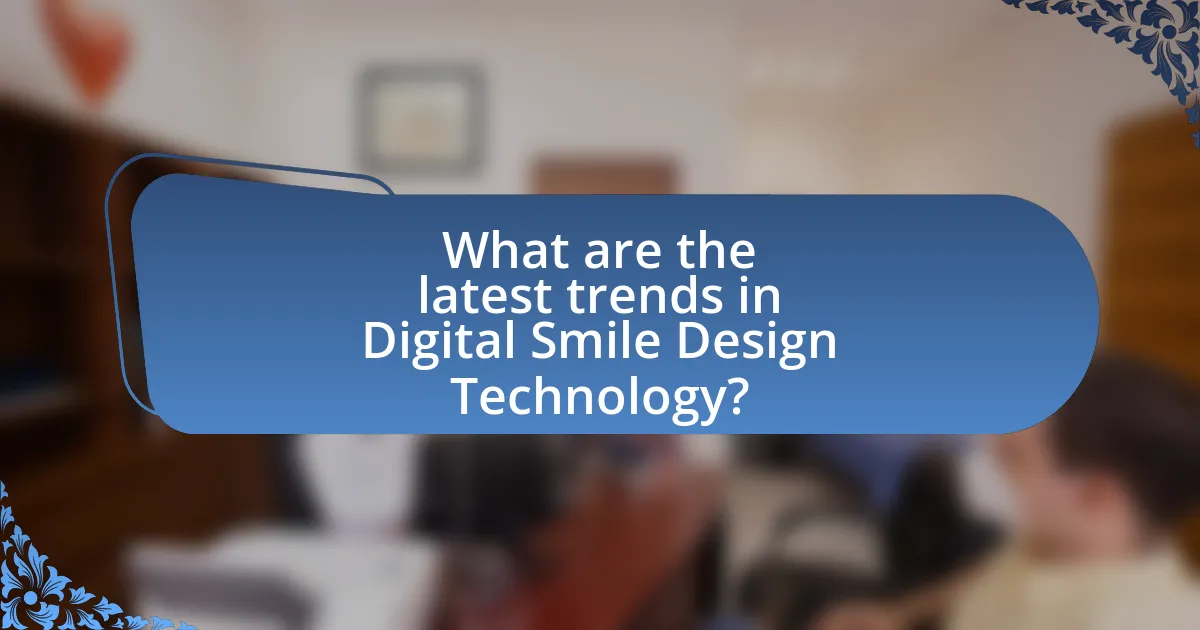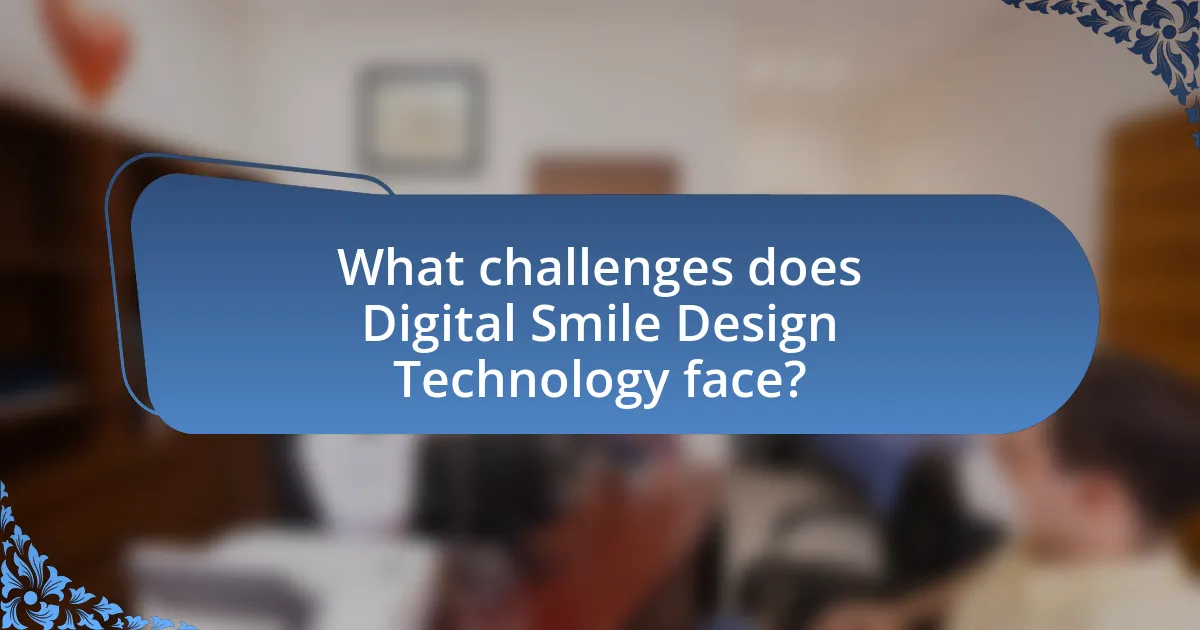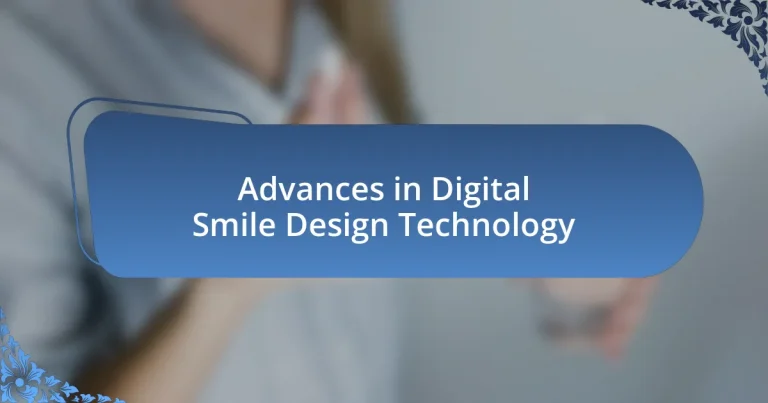Advances in Digital Smile Design Technology focus on enhanced visualization, personalized treatment planning, and improved patient communication, which collectively lead to more efficient dental care. Key features include realistic simulations of potential outcomes, tailored procedures based on patient-specific data, and interactive software that fosters patient engagement. The article explores how this technology enhances dental aesthetics through precise 3D imaging, the tools utilized in the design process, and the role of artificial intelligence in improving treatment accuracy. Additionally, it addresses the challenges faced by dental practices in adopting this technology, including financial barriers and the need for specialized training, while highlighting best practices for effective implementation and patient communication.

What are the key features of Advances in Digital Smile Design Technology?
Advances in Digital Smile Design Technology feature enhanced visualization, personalized treatment planning, and improved patient communication. Enhanced visualization allows dental professionals to create realistic simulations of potential outcomes, enabling patients to see their future smiles before treatment begins. Personalized treatment planning utilizes advanced algorithms and patient-specific data to tailor procedures to individual needs, increasing the effectiveness of treatments. Improved patient communication is achieved through interactive software that engages patients in the design process, fostering better understanding and satisfaction. These features collectively contribute to more efficient and effective dental care, as evidenced by studies showing increased patient acceptance rates and satisfaction levels in treatments utilizing digital smile design technology.
How does Digital Smile Design Technology enhance dental aesthetics?
Digital Smile Design Technology enhances dental aesthetics by allowing for precise visualization and planning of smile transformations. This technology utilizes digital imaging and software to create a 3D representation of a patient’s smile, enabling dentists to design and simulate the desired outcomes before any procedures are performed. Studies have shown that this approach increases patient satisfaction and engagement, as individuals can see a realistic preview of their potential results, leading to more informed decisions regarding their dental treatments. Additionally, the accuracy of the digital designs helps in achieving better alignment and proportion of teeth, which are critical factors in overall smile aesthetics.
What tools are used in Digital Smile Design Technology?
Digital Smile Design Technology utilizes a variety of tools including specialized software, 3D imaging systems, and intraoral scanners. These tools enable dental professionals to create precise digital representations of a patient’s smile, facilitating personalized treatment planning. For instance, software like DSD App allows for the visualization of smile designs, while intraoral scanners capture detailed images of the teeth and gums, enhancing accuracy in the design process. The integration of these tools significantly improves the efficiency and effectiveness of cosmetic dental procedures.
How does software integration improve design accuracy?
Software integration improves design accuracy by enabling seamless data exchange between different design tools and platforms. This interconnectedness allows for real-time updates and modifications, reducing the likelihood of errors that can occur when transferring data manually. For instance, in digital smile design, integrating CAD software with imaging tools ensures that the visual representation of a patient’s smile aligns precisely with the underlying dental structure, leading to more accurate treatment planning. Studies have shown that integrated systems can reduce design discrepancies by up to 30%, thereby enhancing overall treatment outcomes and patient satisfaction.
What role does patient involvement play in Digital Smile Design?
Patient involvement is crucial in Digital Smile Design as it enhances the customization and satisfaction of dental treatments. By actively participating in the design process, patients can express their preferences and expectations, leading to outcomes that align closely with their aesthetic desires. Research indicates that when patients are engaged, they report higher satisfaction rates and improved treatment adherence, as their input helps dental professionals create personalized treatment plans that reflect individual needs and desires. This collaborative approach not only fosters trust between the patient and the dental team but also results in a more predictable and successful aesthetic outcome.
How can patients visualize their treatment outcomes?
Patients can visualize their treatment outcomes through advanced digital smile design technology, which utilizes 3D imaging and simulation software. This technology allows patients to see a realistic preview of their potential results before undergoing any procedures, enhancing their understanding and expectations. Studies have shown that using digital simulations can significantly improve patient satisfaction and decision-making, as it provides a clear visual representation of the anticipated changes in their smile.
What feedback mechanisms are available for patients during the design process?
Patients have several feedback mechanisms available during the design process of digital smile design technology. These mechanisms include surveys, interactive design software, virtual consultations, and direct communication with dental professionals. Surveys allow patients to express their preferences and concerns, while interactive design software enables real-time adjustments based on patient input. Virtual consultations facilitate discussions about design choices, and direct communication ensures that patients can voice their opinions and receive immediate responses. These methods enhance patient engagement and satisfaction, leading to more personalized treatment outcomes.

What are the latest trends in Digital Smile Design Technology?
The latest trends in Digital Smile Design Technology include the integration of artificial intelligence for personalized treatment planning, enhanced 3D imaging techniques for more accurate visualizations, and the use of virtual reality for patient engagement and education. These advancements allow dental professionals to create highly customized smile designs that align with individual patient aesthetics and functional needs. For instance, AI algorithms can analyze facial features and dental proportions to suggest optimal design options, while improved 3D imaging provides detailed representations of potential outcomes, leading to higher patient satisfaction rates.
How is artificial intelligence shaping Digital Smile Design?
Artificial intelligence is significantly shaping Digital Smile Design by enhancing precision in treatment planning and improving patient outcomes. AI algorithms analyze facial features, dental structures, and aesthetic preferences to create personalized smile designs that align with individual patient needs. For instance, AI-driven software can predict the optimal tooth position and shape, leading to more accurate simulations of the final result. Studies have shown that integrating AI in Digital Smile Design can reduce the time required for treatment planning by up to 30%, thereby increasing efficiency in dental practices.
What are the benefits of AI in treatment planning?
AI enhances treatment planning by improving accuracy, efficiency, and personalization in healthcare. It analyzes vast amounts of patient data, enabling healthcare providers to create tailored treatment plans that consider individual patient needs and preferences. For instance, AI algorithms can predict treatment outcomes based on historical data, leading to more informed decision-making. A study published in the Journal of Medical Internet Research found that AI-assisted treatment planning reduced planning time by up to 30% while increasing the precision of treatment recommendations. This demonstrates that AI not only streamlines the planning process but also contributes to better patient outcomes.
How does AI improve patient-specific design outcomes?
AI enhances patient-specific design outcomes by utilizing advanced algorithms to analyze individual patient data, leading to tailored treatment plans. These algorithms can process vast amounts of information, including facial structure, dental anatomy, and aesthetic preferences, to create personalized designs that align with the patient’s unique characteristics. For instance, studies have shown that AI-driven systems can increase the accuracy of smile design by up to 30%, ensuring that the final results meet the specific aesthetic goals of each patient. This precision not only improves patient satisfaction but also optimizes the overall treatment process, making it more efficient and effective.
What advancements have been made in 3D printing for dental applications?
Recent advancements in 3D printing for dental applications include the development of biocompatible materials, enhanced printing speeds, and improved accuracy in creating dental prosthetics. These innovations allow for the production of customized dental implants, crowns, and aligners with a precision level that significantly reduces the need for adjustments. For instance, the introduction of resin-based materials specifically designed for dental use has led to better aesthetic outcomes and durability. Additionally, technologies such as digital light processing (DLP) and selective laser sintering (SLS) have accelerated the printing process, enabling quicker turnaround times for dental restorations. These advancements are supported by studies demonstrating that 3D-printed dental devices can achieve a fit accuracy of up to 98%, which is crucial for patient satisfaction and clinical success.
How does 3D printing enhance the production of dental models?
3D printing significantly enhances the production of dental models by enabling precise and rapid fabrication of customized dental structures. This technology allows for the creation of highly accurate models that reflect the unique anatomy of each patient, which is crucial for effective treatment planning and execution. For instance, studies have shown that 3D-printed dental models can achieve dimensional accuracy within 50 micrometers, which is essential for ensuring proper fit and function of dental restorations. Additionally, 3D printing reduces the time required for model production from days to hours, streamlining workflows in dental practices and laboratories. This efficiency not only improves patient outcomes but also increases the overall productivity of dental professionals.
What materials are commonly used in 3D printing for dental designs?
Common materials used in 3D printing for dental designs include biocompatible resins, dental ceramics, and thermoplastics. Biocompatible resins, such as those used in stereolithography (SLA) and digital light processing (DLP), are favored for their precision and ability to create detailed models for crowns and bridges. Dental ceramics, like zirconia, are utilized for their strength and aesthetic qualities, making them suitable for permanent restorations. Thermoplastics, such as polyamide (nylon) and polycarbonate, are often employed for orthodontic appliances due to their durability and flexibility. These materials are validated by their widespread use in dental practices and their compliance with health regulations, ensuring safety and effectiveness in dental applications.

What challenges does Digital Smile Design Technology face?
Digital Smile Design Technology faces challenges such as high implementation costs, the need for specialized training, and integration with existing dental practices. High costs can deter dental professionals from adopting the technology, as initial investments in software and hardware can be significant. Additionally, the technology requires practitioners to undergo specialized training to effectively utilize the tools, which can be time-consuming and may lead to a steep learning curve. Furthermore, integrating Digital Smile Design into established workflows can be complex, as it necessitates changes in practice management and patient interaction processes. These challenges can hinder widespread adoption and limit the technology’s potential benefits in enhancing patient outcomes and satisfaction.
How do costs impact the adoption of Digital Smile Design Technology?
Costs significantly impact the adoption of Digital Smile Design Technology by influencing both initial investment and ongoing operational expenses. High costs can deter dental practices from integrating this technology, as they may require substantial financial resources for software, hardware, and training. For instance, a study published in the Journal of Dental Research indicated that practices with lower financial flexibility are less likely to adopt advanced technologies, including Digital Smile Design, due to concerns about return on investment. Additionally, ongoing costs related to software updates and maintenance can further complicate adoption, as practices must weigh these expenses against potential revenue increases from enhanced patient satisfaction and treatment outcomes.
What are the financial barriers for dental practices?
Financial barriers for dental practices include high startup costs, ongoing operational expenses, and limited access to financing options. High startup costs often encompass equipment purchases, facility renovations, and initial marketing efforts, which can exceed hundreds of thousands of dollars. Ongoing operational expenses, such as staff salaries, rent, and supplies, can strain cash flow, particularly for new practices. Additionally, limited access to financing options, including loans and credit lines, can hinder growth and investment in advanced technologies like Digital Smile Design, which requires significant capital. According to the American Dental Association, nearly 30% of dental practices report financial challenges related to these factors, impacting their ability to adopt new technologies and improve patient care.
How can practices justify the investment in this technology?
Practices can justify the investment in Digital Smile Design technology by demonstrating its potential to enhance patient satisfaction and improve clinical outcomes. This technology allows for precise visualizations of treatment plans, leading to better communication with patients and increased acceptance rates of proposed procedures. Research indicates that practices utilizing Digital Smile Design report a 30% increase in case acceptance, as patients are more likely to proceed with treatments when they can visualize the expected results. Additionally, the technology can streamline workflows, reducing chair time and increasing overall practice efficiency, which can lead to higher revenue generation.
What are the limitations of current Digital Smile Design tools?
Current Digital Smile Design tools have limitations including a lack of standardization, reliance on subjective interpretation, and potential inaccuracies in 3D modeling. These tools often vary in their algorithms and user interfaces, leading to inconsistent results across different platforms. Additionally, the subjective nature of aesthetic preferences can result in varying outcomes based on the clinician’s interpretation, which may not align with patient expectations. Furthermore, inaccuracies in 3D modeling can arise from limitations in capturing the nuances of dental anatomy and facial features, potentially affecting the final treatment plan.
How do software limitations affect design outcomes?
Software limitations significantly restrict design outcomes by constraining the capabilities of digital tools used in design processes. These limitations can lead to reduced accuracy in modeling, limited customization options, and hindered integration with other technologies. For instance, software that lacks advanced rendering capabilities may produce less realistic visualizations, impacting the decision-making process for dental professionals. Additionally, studies have shown that software with limited user interfaces can result in increased design errors, as users may struggle to navigate complex functionalities effectively. This ultimately affects the quality and precision of the final design, demonstrating that software capabilities directly influence the success of design outcomes in digital smile design technology.
What are the common user experience challenges faced by dental professionals?
Dental professionals commonly face user experience challenges such as inadequate software integration, complex user interfaces, and insufficient training on digital tools. Inadequate software integration can lead to inefficiencies, as dental professionals often use multiple systems that do not communicate effectively, resulting in data silos. Complex user interfaces can hinder usability, making it difficult for practitioners to navigate digital smile design tools efficiently. Additionally, insufficient training on these technologies can lead to underutilization of features, impacting the overall effectiveness of digital smile design in practice. These challenges are supported by studies indicating that user satisfaction is significantly influenced by the ease of use and integration of dental software systems.
What best practices should dental professionals follow when implementing Digital Smile Design Technology?
Dental professionals should follow a structured approach when implementing Digital Smile Design (DSD) Technology, focusing on patient communication, accurate data collection, and collaborative treatment planning. Effective patient communication is essential, as it helps to align patient expectations with clinical outcomes, ensuring that patients are actively involved in the design process. Accurate data collection, including high-quality photographs, digital impressions, and facial analysis, is crucial for creating a precise digital smile design that reflects the patient’s unique features. Collaborative treatment planning involves engaging the entire dental team, including specialists, to ensure that all aspects of the patient’s care are considered, leading to a comprehensive and cohesive treatment strategy. These practices enhance the overall effectiveness of DSD Technology, resulting in improved patient satisfaction and clinical results.
How can training improve the effectiveness of Digital Smile Design tools?
Training enhances the effectiveness of Digital Smile Design tools by equipping dental professionals with the necessary skills to utilize the software optimally. Proficient training ensures that users understand the full range of features and functionalities, leading to more accurate and aesthetically pleasing smile designs. Research indicates that trained practitioners can achieve a 30% increase in patient satisfaction due to improved design precision and communication of treatment plans. Furthermore, training fosters a deeper understanding of digital workflows, which can reduce errors and streamline the design process, ultimately resulting in better clinical outcomes.
What strategies can enhance patient communication during the design process?
Effective strategies to enhance patient communication during the design process include utilizing visual aids, engaging in active listening, and implementing digital tools for real-time feedback. Visual aids, such as 3D models and simulations, help patients better understand proposed designs, making complex information more accessible. Active listening fosters a two-way dialogue, allowing patients to express their concerns and preferences, which can lead to more tailored solutions. Additionally, digital tools like patient portals and communication apps facilitate ongoing interaction, enabling patients to provide input and ask questions throughout the design process. These strategies collectively improve clarity and satisfaction, as evidenced by studies showing that enhanced communication leads to better patient outcomes and increased trust in healthcare providers.


